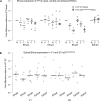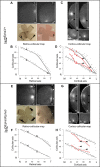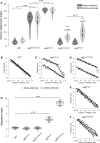New insights on the modeling of the molecular mechanisms underlying neural maps alignment in the midbrain
- PMID: 32996883
- PMCID: PMC7527235
- DOI: 10.7554/eLife.59754
New insights on the modeling of the molecular mechanisms underlying neural maps alignment in the midbrain
Abstract
We previously identified and modeled a principle of visual map alignment in the midbrain involving the mapping of the retinal projections and concurrent transposition of retinal guidance cues into the superior colliculus providing positional information for the organization of cortical V1 projections onto the retinal map (Savier et al., 2017). This principle relies on mechanisms involving Epha/Efna signaling, correlated neuronal activity and axon competition. Here, using the 3-step map alignment computational model, we predict and validate in vivo the visual mapping defects in a well-characterized mouse model. Our results challenge previous hypotheses and provide an alternative, although complementary, explanation for the phenotype observed. In addition, we propose a new quantification method to assess the degree of alignment and organization between maps, allowing inter-model comparisons. This work generalizes the validity and robustness of the 3-step map alignment algorithm as a predictive tool and confirms the basic mechanisms of visual map organization.
Keywords: Eph/Efn signalling; computational biology; modelling; mouse; neuroscience; retinal development; superior colliculus; systems biology; visual system.
© 2020, Savier et al.
Conflict of interest statement
ES, JD, KC, MR No competing interests declared
Figures






Similar articles
-
New model of retinocollicular mapping predicts the mechanisms of axonal competition and explains the role of reverse molecular signaling during development.J Neurosci. 2012 Jul 11;32(28):9755-68. doi: 10.1523/JNEUROSCI.6180-11.2012. J Neurosci. 2012. PMID: 22787061 Free PMC article.
-
A relative signalling model for the formation of a topographic neural map.Nature. 2004 Oct 14;431(7010):847-53. doi: 10.1038/nature02957. Nature. 2004. PMID: 15483613
-
A molecular mechanism for the topographic alignment of convergent neural maps.Elife. 2017 Mar 14;6:e20470. doi: 10.7554/eLife.20470. Elife. 2017. PMID: 28322188 Free PMC article.
-
Molecular gradients and development of retinotopic maps.Annu Rev Neurosci. 2005;28:327-55. doi: 10.1146/annurev.neuro.28.061604.135714. Annu Rev Neurosci. 2005. PMID: 16022599 Review.
-
Molecular guidance of retinotopic map development in the midbrain.Curr Opin Neurobiol. 2014 Feb;24(1):7-12. doi: 10.1016/j.conb.2013.07.006. Epub 2013 Aug 31. Curr Opin Neurobiol. 2014. PMID: 24492072 Review.
Cited by
-
Segregation of Multimodal Inputs Into Discrete Midbrain Compartments During an Early Critical Period.Front Neural Circuits. 2022 Apr 7;16:882485. doi: 10.3389/fncir.2022.882485. eCollection 2022. Front Neural Circuits. 2022. PMID: 35463204 Free PMC article.
-
Postsynaptic NMDA Receptor Expression Is Required for Visual Corticocollicular Projection Refinement in the Mouse Superior Colliculus.J Neurosci. 2023 Feb 22;43(8):1310-1320. doi: 10.1523/JNEUROSCI.1473-22.2022. Epub 2023 Jan 30. J Neurosci. 2023. PMID: 36717228 Free PMC article.
-
Editorial: Development and plasticity of multisensory circuits.Front Neural Circuits. 2023 Jan 13;16:1129196. doi: 10.3389/fncir.2022.1129196. eCollection 2022. Front Neural Circuits. 2023. PMID: 36712836 Free PMC article. No abstract available.
References
Publication types
MeSH terms
Substances
Grants and funding
LinkOut - more resources
Full Text Sources
Molecular Biology Databases
Miscellaneous

